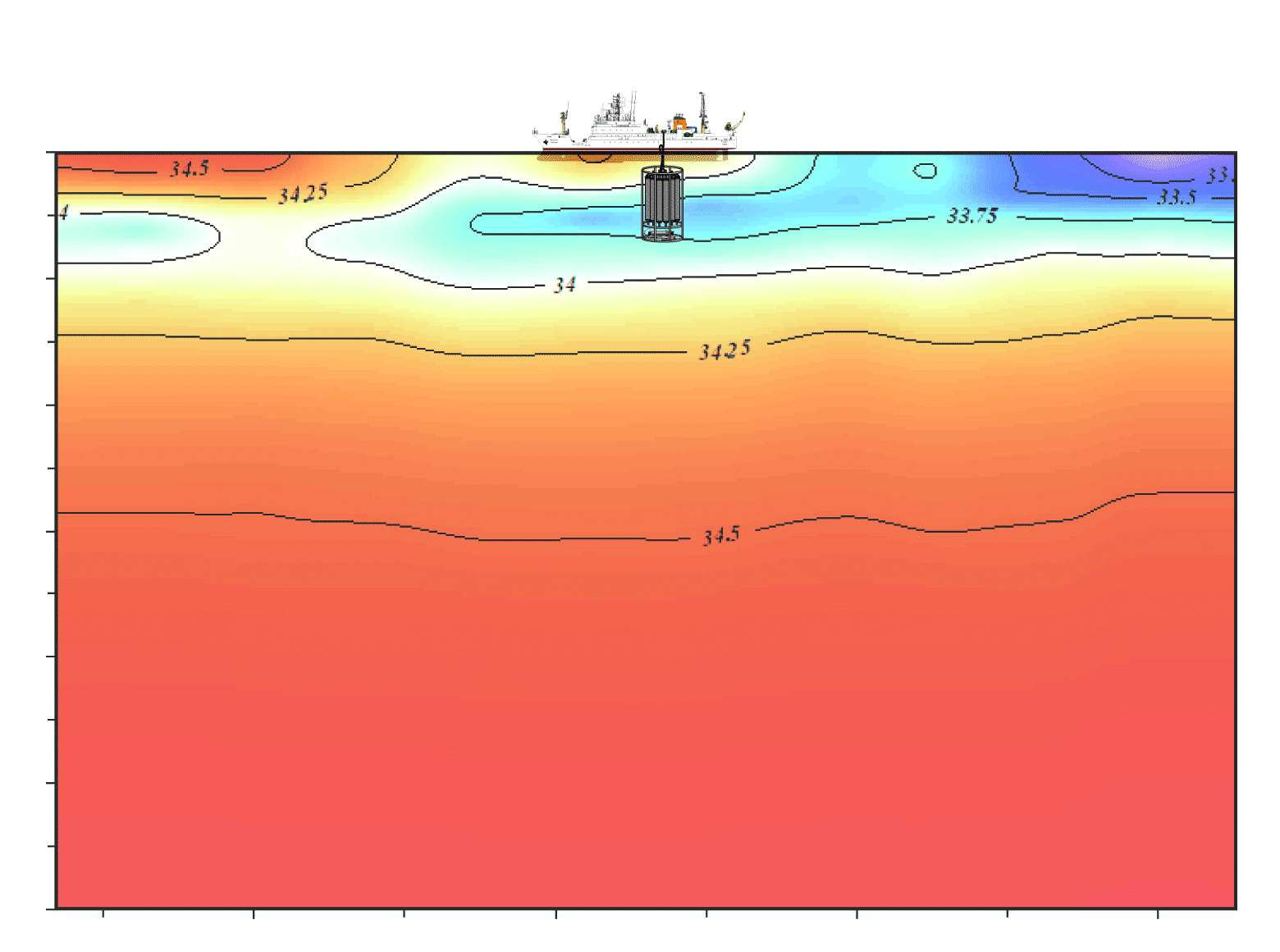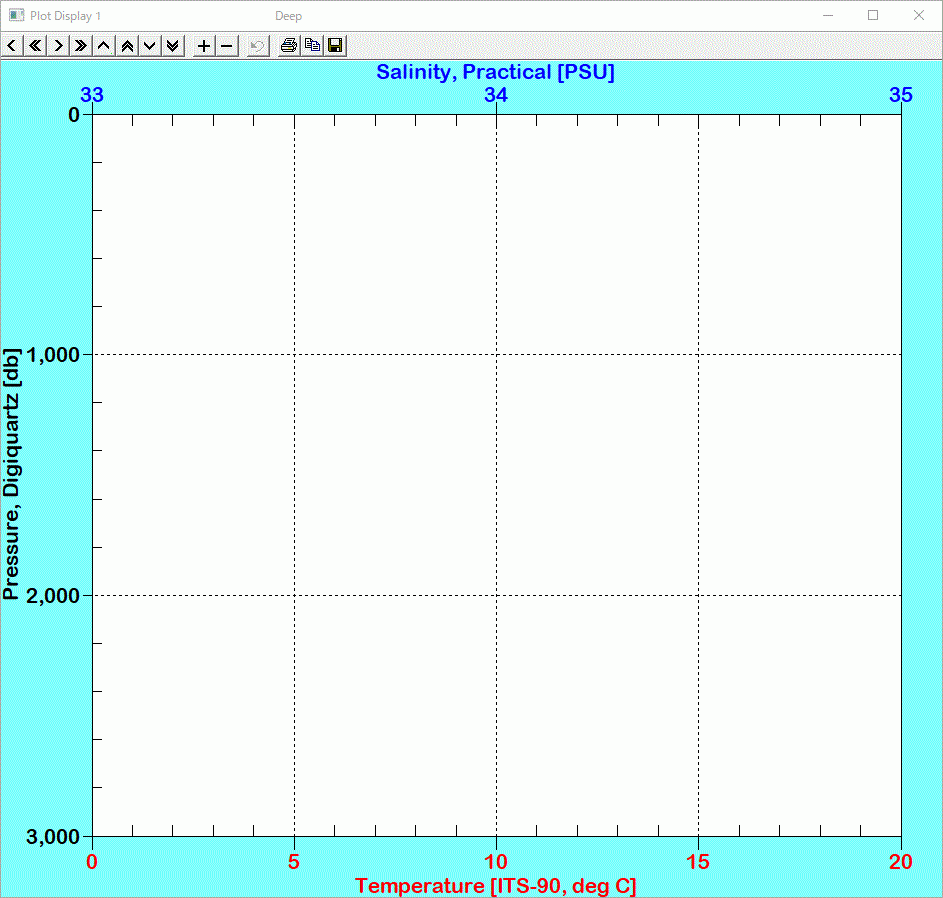CTD water sampling system
セクションアウトライン
-
KEIRI Imai, KENJI Oguma, and KOUKI Sawada, Oshoro-maru Marine Science Department, School of Fisheries Sciences, Hokkaido University
-
The CTD water sampling system is a combination of a wired CTD, a water sampling device, and a water sampler. It is an observation system that measures the vertical distribution of water temperature and salinity, and collects seawater from any layer while monitoring the measured values.
Fig 1 CTD observation (CTD water sampling system submersible station is being deployed into the sea)
-
The system consists of an underwater station that combines a CTD sensor and a water sampling device, an onboard station (a deck unit that receives data sent from the underwater station and a data recording PC that records and displays data received by the deck unit), and cables connecting them (Figure 2, 3, 4, 5). The underwater station is lifted above the sea surface using a crane, and then lowered into the sea by unrolling a special cable called an armored cable (coaxial cable covered with steel wire) wound on a winch. The values measured by the underwater station are immediately transmitted to the deck unit via the armored cable. The measurement data received by the deck unit is stored in a data recording PC and simultaneously monitored using dedicated software. In addition, the Niskin water sampler lid can be closed by emitting a water sampling signal from the onboard station to collect a seawater sample from any layer.
Fig 2 CTD water sampling system Configuration
・船上局 Onboard operation section
データ収録PC Data recording PC
デッキユニット Deck Unit
船内配線 Wiring on boardCTDウィンチ CTD Winch
アーマードケーブル armored cable
・水中局 In-water section
ニスキン採水器 Niskin water sampler
採水装置 Water sampling equipment
CTD
フレーム FrameFig 3 Configuration of CTD onboard station
デッキユニット Deck Unit
水中局へ To the In-water section
データ収録PC Data recording PC
入出力機器(モニタ,キーボード,マウス) Input/output devices (monitor, keyboard, mouse)
Onboard stations consist of deck units, data recording PCs, monitors, and other input/output equipment. The photo shows the CTD operation room of the training ship Oshoro Maru (Hokkaido University), where two deck units and two data recording PCs are housed in a rack, and monitors and keyboards are installed right next to them.
Figure 4 Configuration of CTD underwater stations
アーマードケーブル Armored cable
多筒採水装置 Multibarrel water sampler
ニスキン採水器 Niskin water sampler
保護フレーム Protective frame
採水器架台 Water sampler mounts
CTDセンサ CTD sensor
Fig 5 Multibarrel water sampler
a) A latch that serves as a water sampling trigger is arranged in a radial pattern at the top of the water sampling device, and water samplers are placed around the latch. The latch is held open by hooking the tegus attached to the lid of the water sampler to the latch. b) When the water sampling device receives the water sampling signal, the latch is released and the lid of the sampler closes.
-
Observations using the CTD water sampling system are performed in cooperation with (1) operators, (2) On-site workers, (3) Winch operator, and (4) ship bridge duty personnel (Figure 6).
Fig.6 Division of work for CTD observations
CTD観測 CTD observations
・オペレーター Operator
船上局の操作 Operation of shipboard stations
データの監視 Data Monitoring
野帳の記録 Field notebook records
・現場作業者 On-site workers
採水器のセッティング Setting up water sampling equipment
水中局の投入,揚収作業 Underwater station loading and unloading
・ウィンチマン Winch operator
ウインチ,クレーンの操作 Operation of winches and cranes
・船橋当直者 Ship bridge duty personnel
操船 Handling a ship
① Operator
The software on the onboard station and data recording PC are operated in the onboard operation room (Figure 7). During the observation, the winchman is instructed to stop, wind up, and unload the winch at the necessary timing while checking on the monitor that the data is being acquired normally. In addition, the date and time of the observation, ship's position (latitude and longitude), weather conditions, and other information are recorded in a logbook called a field notebook. The operator is also responsible for stopping the submersible station at a pre-determined water sampling depth, sending a water sampling signal from the onboard station, and closing the lid of the water sampler. The operator monitors data in real time, gives instructions to each person in charge of the work, and collects information, and thus serves as the control tower for the observation.
Fig.7 CTD Operations
② On-site workers
The underwater station will be deployed on the observation deck. Before deploying the station, the lid of the water sampler is opened and the water sampling device is prepared for deployment in the sea. During the loading and unloading operations, the submersible station is secured with ropes to prevent it from swinging around due to the ship's motion. Once the underwater station has been lifted, the seawater sample is separated from the water sampler (water distribution) (Figure 8).
Fig.8 Water distribution
③ Winch operator
Operates winches and cranes in the winch control room. During observation, the winch is stopped, hoisted, and unloaded in response to instructions from the operator.
④ Ship bridge duty personnel
During the observation, the vessel is maneuvered to maintain the vessel's observation configuration while taking into account current, wind, and wave conditions in accordance with instructions from the operator, on-site workers, and winch operator. Maneuvering involves adjusting rudder angle, wing angle, and attitude control propellers called thrusters. Especially during the loading and unloading of underwater stations, skill is required to minimize the ship's rolling motion. -
Observations with the CTD water sampling system are made while the vessel is stationary. Once the ship arrives at the observation site and enters the observation mode, the ship proceeds in the order shown in Figure 9: in CTD observation, "Down Cast" is defined as lowering the underwater station into the sea by uncoiling the wire, while "Up Cast" is defined as raising the underwater station in the sea by coiling the wire.
Fig.9 CTD observation work flow
採水器のセッティング Setting up water sampling equipment
水中への投入作業 Loading operation into the water
ダウンキャスト Down Casting
アップキャスト,採水 Up Casting and collecting water
船上への揚収作業 Unloading to ship
配水作業 Water distribution
① Setting up water sampling equipment
Before feeding the underwater station, open the top and bottom lids of the water sampler to prepare the water sampling device for feeding. Also, make sure that the water sampler intake and air vent are closed (Figure 10).Fig.10 Setting up water sampling equipment
採水装置トリガー部拡大図 Enlarged view of water sampling device trigger section
スナップフック拡大図 Enlarged view of snap hook
エアベント拡大図 Enlarged view of air vent
ペットコック拡大図 Enlarged view of Petcock
a) Hook the end of the tegus connected to the upper lid onto the trigger of the water sampling device to secure the upper lid in the open position.
b) Secure the lower lid in the open position by hooking the snap hook on the lower end of the lower lid's ring-shaped texus, which is branched off from the upper lid's texus and extended downward.
c) Make sure that the air vent (air hole) and PETCOCK (water sampling port) are closed. The air vent is closed by turning clockwise and screwing it in. The PET cock is closed by pulling it out toward you.② Loading operation into the water
After the underwater station is lifted above the sea surface by crane, the cable is unloaded and placed in the water. During this operation, the underwater station is secured by ropes or other means to prevent it from swinging around due to hull movement. If the underwater station swings around, it may collide with the port side, damaging sensors and water sampling equipment, or injuring the operator.
③Down casting
After placing the cable into the sea, the operator operates the on-board station to begin data acquisition. The cable is unloaded to the desired depth and the vertical profile is continuously measured. The operator stops the cable ejection at the desired depth based on the output value of the CTD's pressure sensor.
④ Up castingWater sampling is performed at an arbitrary depth before the cable is wound up and the submersible station is retrieved on board. While monitoring the value of the CTD sensor, the operator stops winding the wire at the pre-determined water sampling depth, then sends a water sampling signal from the onboard station to the submersible station and closes the lid of the water sampler.
⑤ Unloading to ship
Once the water sampling is completed, the underwater station is lifted on board.
⑥ Water distribution
Once the underwater station is pumped on board, the seawater sample is sorted from the water sampler into sample bottles (water distribution).
-
Figure 11 shows a schematic representation of the vertical profiles of water temperature and salinity drawn in the software in conjunction with the movement of the underwater station during CTD observations. The vertical axis of the graph represents depth; the lower the graph, the deeper the depth. In addition, water temperature is taken on the first abscissa (red) and salinity on the second (blue), with the right side indicating higher values. When water sampling is performed, a mark line is drawn at that depth point.


Fig.11 CTD observation image and observation window

